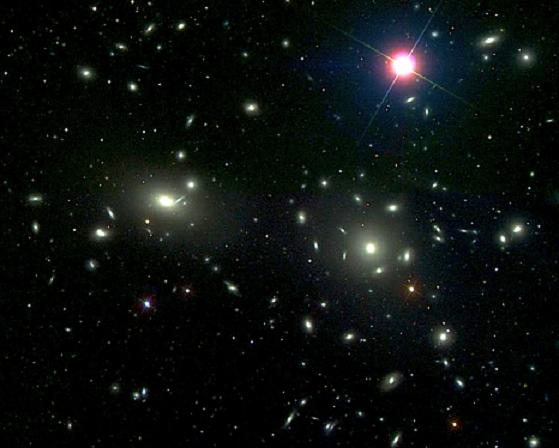Filaments and Fireballs
Apr 21, 2009
Recent images of the Coma Cluster
from the Subaru Telescope reveal
galactic filaments connecting bright
"knots" of ionized gas.
According to redshift calculations, the Coma Cluster is a
sphere of galaxies 3.5 million light years in diameter over
300 million light years from Earth. The cluster is one of
the most compact mass accumulations in the observable
universe with more than 1000 galaxies grouped together
inside a haze of gas and dust that has been measured at a
temperature of 100 million Kelvin. Astronomers continue to
ponder the intense x-ray emissions blaring out from Coma's
central region, a finding that has, thus far, eluded
theoretical explanation.
Scientists analyzing data from the Subaru Telescope
recently announced the discovery of a "thread-like
structure" emerging from RB199, one of the larger elliptical
galaxies inhabiting the cluster. The filament extends
approximately 260,000 light years from RB199 and contains
groups of stars in close association that are enclosed by
glowing, ionized shells. Researchers refer to these rapidly
moving star cluster knots as "fireballs,"
because they look like flaming projectiles shooting out from
the galaxy.
What caused the compact clumps of stars to form? One
proposal was that gravitational "tidal forces" pulled stars
and gas out from RB199 as another galaxy passed close by.
Another suggestion was based on the movement of the galaxy
toward the center of the Coma Cluster. As it accelerated
into the central mass of the cluster, the blow-back force
could have pushed the formations out and away from the
direction of travel like a cosmic comet tail. However,
neither conjecture was able to accommodate the
characteristics of the stars and the knotted gas whose
temperature was found to exceed tens of million Kelvin.
The
Subaru team finally concluded that RB199 is being affected
by "ram pressure" as it "crashes into the center" of the
galaxy cluster. It is actually friction from the Coma
Cluster's hot gases interacting with the galaxy moving at
almost 2000 kilometers per second that formed the long
filaments. Gas and dust scraping against each other stripped
material off RB199 and created the superheated stellar
fireballs.
Dr.
Michitoshi Yoshida, the Subaru team's lead investigator
said: “The team is confident that our study of these
phenomena leads to a better understanding of the gas
stripping processes in galaxy clusters, and the effect of
clusters on the evolution of individual galaxies."
Irony aside, wind socks, shock waves and collisions are
often used to describe phenomena that create high-frequency
electromagnetic radiation in the cosmos. Since the beginning
of advanced astronomy, conventional theorists have relied on
gravity and acceleration for the production of gamma rays,
x-rays and extreme ultraviolet light in space. Hydrogen gas
compression is supposed to create enough transfer of
momentum that it reaches temperatures greater than the cores
of some stars. In other words, it is the high temperature of
the gas that makes it glow so brightly.
In
previous Picture of the Day articles, we noted that many
structures in the universe are active energy sources—some
galaxies eject charged matter out from their poles, or leave
long braided tails extending for thousands of light-years.
Smaller formations (stars and planetary nebulae) have
hourglass shapes composed of tightly bunched filaments. Such
filamentary structures are known as Birkeland currents.
Plasma cosmologists have long known that the filaments
extending from active "radio" galaxies to the "radio lobes"
far above their poles are the signature of Birkeland
currents. Almost every body in the universe displays some
kind of filamentation. Venus, for example, has a tail
composed of what NASA scientists call "stringy things."
Comet tails are composed of "stringy" ion tails. The glow
from planetary nebulae resolve into intricate webs. The jets
of Herbig-Haro stars and energetic galaxies are often
resolved into braided filaments, and the spiral arms of some
galaxies look "hairy" with threads of material extending
from them.
All
those filaments are Birkeland currents, but they only
represent the visible portion of an entire circuit. The rest
of the circuit may generate magnetic fields that can be
mapped, so the map will indicate the extent of the circuit.
Every element in a galactic circuit radiates energy, and it
must be powered by its coupling with larger circuits. The
extent of those larger circuits is indicated by the
observation that
galaxies occur in strings.
In
conclusion, it seems apparent that the filamentary knots
exploding outward from RB199 are another example of
electricity in space forming glowing "fireballs" of plasma
in the electromagnetic pinch zones of cosmic currents.
By
Stephen Smith







